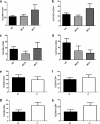Fingolimod modulates peripheral effector and regulatory T cells in MS patients
- PMID: 23649711
- PMCID: PMC3889247
- DOI: 10.1007/s11481-013-9465-5
Fingolimod modulates peripheral effector and regulatory T cells in MS patients
Abstract
Multiple sclerosis (MS) is a complex neurological disease where, in genetically predisposed individuals, the unbalanced interplay between pathogenic and regulatory T cells will result in the progression of the autoimmune assault to neural antigens. Fingolimod (FTY720), an oral sphingosine 1-phosphate modulator recently approved for the treatment of MS, inhibits the egress of T cells from lymph nodes acting specifically on naïve and memory T cells and sparing effector T cells. Here we characterized IL-17 and IFNγ producing effector CD4 and CD8 positive T cells as well as CD4 positive CD25(high)CD127(low) regulatory T cells in MS patients before and 1 month after treatment was started. We observed that fingolimod did not significantly affect the percentage of CCR6 and CD161 positive T cells in both CD4 and CD8 compartments. In contrast, it significantly reduced the levels of both CD4+ CCR6+ CD161+ and CD8+ CCR6+ CD161+ producing IFNγ alone or in combination with IL-17. The percentage of IL-17 secreting cells in both subsets was affected by the treatment to a lesser extent. Finally, we observed that CD4+ CD25(high)CD127(low) regulatory T cells were decreased in MS patients compared to healthy controls and fingolimod significantly increased their frequencies. All together these findings demonstrate that fingolimod functionally modulates the ability of potentially pathogenic effector cells to produce relevant pro-inflammatory cytokines and increases the number of circulating regulatory T cells possibly contributing in restoring a balance between these populations.
Figures




Comment in
-
Recurrent varicella following steroids and fingolimod in a Multiple Sclerosis patient.J Neuroimmune Pharmacol. 2013 Dec;8(5):1059-61. doi: 10.1007/s11481-013-9510-4. Epub 2013 Oct 27. J Neuroimmune Pharmacol. 2013. PMID: 24163092 No abstract available.
References
-
- Annibali V, Ristori G, Angelini DF, Serafini B, Mechelli R, Cannoni S, Romano S, Paolillo A, Abderrahim H, Diamantini A, Borsellino G, Aloisi F, Battistini L, Salvetti M. CD161(high)CD8+ T cells bear pathogenetic potential in multiple sclerosis. Brain. 2011;134:542–554. doi: 10.1093/brain/awq354. - DOI - PubMed
-
- Borsellino G, Kleinewietfeld M, Di Mitri D, Sternjak A, Diamantini A, Giometto R, Hopner S, Centonze D, Bernardi G, Dell’Acqua ML, Rossini PM, Battistini L, Rotzschke O, Falk K. Expression of ectonucleotidase CD39 by Foxp3+ Treg cells: hydrolysis of extracellular ATP and immune suppression. Blood. 2007;110:1225–1232. doi: 10.1182/blood-2006-12-064527. - DOI - PubMed
Publication types
MeSH terms
Substances
LinkOut - more resources
Full Text Sources
Other Literature Sources
Research Materials

